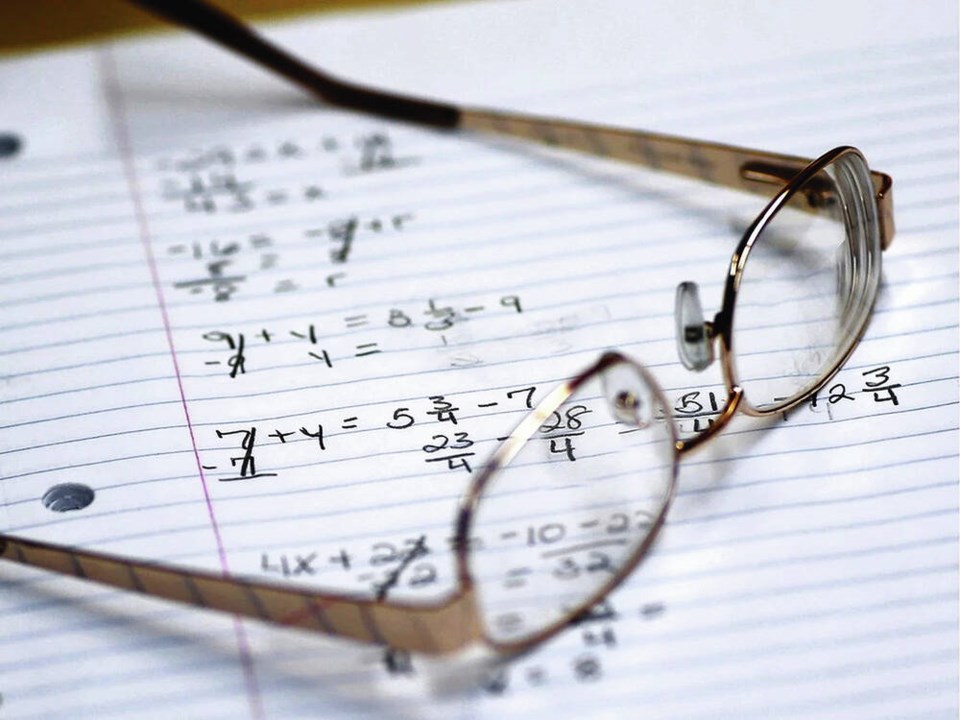A commentary by an Oak Bay resident.
There seems to be some angst and handwringing over the perceived state of math achievement and instruction in public schools.
Achievement on the part of our students as measured by an objective standard, in most cases a standardized test, seems not to be on par with students in some other countries, or with provincial expectations.
One would hope in the latter case the concern is warranted greater attention as the measurement standard should be based on the mathematics curriculum developed by the province and taught in our schools.
An international test may lack some relevance in our situation if it is discordant with our curriculum at the particular grade levels. Rather like expecting the biology students to do well on the chemistry test.
Much of this angst seems to be on the part of parents who are driven by the notion that mathematics instruction should focus on basic facts and algorithms to be memorized, and then applied.
On the other hand, those experienced through teacher training and practice realize that memorization is a lower order thinking skill and is different from understanding mathematical concepts.
A good example is a parent who proudly proclaims that their four-year-old can count to 10, and in three languages. What the child has often done is memorize the words, just as they would a song or poem.
Each numerical name represents a quantity, and a child does not understand counting until they can make the one-to-one visual correspondence.
Effective instruction is based on the understanding that one needs the cognitive ability to see five as a quantity to know what five is beyond just a word.
When parents query the effectiveness of instruction in our schools it is important to consider whether they are speaking about their own child as a student, or student achievement in general.
When it comes to understanding mathematical concepts there will always be those students who gain knowledge and skill with ease, just as there are those who have no trouble becoming literate.
Adults often describe themselves when reflecting on their school experiences as being good at math, or alternatively struggling in math, but excelling in language related courses.
And, just as some will have a learning disability that might cause challenges learning to decode print, there are those with nonverbal learning disabilities causing genuine difficulties in becoming numerate. One should expect such students would not perform well on a standardized test.
Effective mathematics instruction always begins from the very earliest grades dealing in the concrete, with teachers requiring the use of manipulative materials, such as base ten blocks.
Without concrete understandings a learner will struggle in moving to the symbolic, then the abstract.
Students who are good memorizers can feign understanding but are the ones who often struggle in the higher grades as abstract thinking is required. A parent may well wonder why their child struggles at the higher grades when they seemed such able learners earlier on.
Memorization of basic facts and simple algorithms for computation will only go so far, no matter how accurately applied. They won’t help, for example, with solving algebraic equations, an expectation in higher grades.
An examination of cross grade mathematics curricula shows that the foundation for this starts with understanding patterns as early as Kindergarten, a very visual activity.
Teachers understand that truly fluent mathematical thinkers can apply more than one algorithm to solve computational problems.
Traditionally in this country, for example, when teaching double digit addition, students are taught to add the ones column first, then add anything greater than ten to the tens column to get the answer.
Another way to solve the same problem would be to add the tens column first, then the ones, then add the two together. Children who are memorizers tend to learn one algorithm and use it consistently.
So, what are the responsibilities of the different constituent groups in ensuring effective instruction in mathematics?
It starts with teacher training. Universities must ensure that students who enter their teacher training programs with the goal of becoming responsible for mathematics instruction at any grade level have certain proficiency themselves, including course requirements.
As well, there should be a mandatory requirement to successfully complete a methods course in how to teach numeracy. It shouldn’t be assumed that because one understands a certain subject, that one also understands how to teach that subject.
School districts should show leadership at the system level with personnel dedicated to ensuring proven and effective instruction occurs. School administrators can assist by organizing relevant, continuing professional development opportunities for staff, the appropriate resources, and information for parents.
When parents have questions or concerns about their child’s education it is often difficult for them to know who to listen to and what to do. There are always the voices of those with opinions, but a parent might wonder if it is an informed one.
It is usually best to listen to those who have actual expertise and experience, no matter the area. Parents should be encouraged to take any of their questions and concerns to their child’s school.
All staff must be able to justify their approaches to teaching and be held accountable for an effective learning environment. And, they should be proud of, and happy to explain their work with students.
This type of communication would help to reduce the angst.




